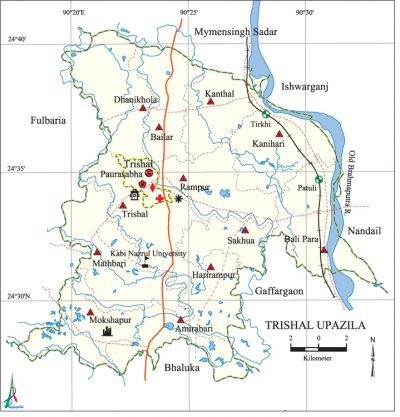Trishal Upazila
Trishal Upazila (mymensingh district) area 338.98 sq km, located in between 24°28' and 24°41' north latitudes and in between 90°18' and 90°32' east longitudes. It is bounded by mymensingh sadar upazila on the north, bhaluka and gaffargaon upazilas on the south, ishwarganj, nandail and Gaffargaon upazilas on the east, fulbaria upazila on the west.
Population Total 372498; male 190428, female 182070; Muslim 361731, Hindu 10340, Buddhist 16, Christian 15 and others 396.
Water bodies Main river: old brhramaputra.
Administration Trishal Thana was formed in 1909 and it was turned into an upazila in 1983.
| Upazila | ||||||||
| Municipality | Union | Mouza | Village | Population | Density (per sq km) | Literacy rate (%) | ||
| Urban | Rural | Urban | Rural | |||||
|
1 |
12 |
91 |
159 |
43580 |
328918 |
1099 |
47.7 |
39.2 |
| Municipality | |||||
|
Area (sq km) |
Ward |
Mahalla |
Population |
Density (per sq km) |
Literacy rate (%) |
|
15.48 |
9 |
12 |
25429 |
1643 |
57.5 |
| Upazila Town | |||||
|
Area (sq km) |
Mouza |
Population |
Density (per sq km) |
Literacy rate (%) | |
|
19.35 |
1 |
18151 |
938 |
33.1 | |
| Union | ||||
| Name of union and GO code | Area (acre) | Population | Literacy rate (%) | |
| Male | Female | |||
|
Amirabari 13 |
5111 |
9601 |
9214 |
40.82 |
|
Kanthal 57 |
5842 |
13316 |
12918 |
42.25 |
|
Kanihari 47 |
7780 |
18033 |
17839 |
33.05 |
|
Trishal 85 |
9110 |
15846 |
14633 |
40.71 |
|
Dhanikhola 28 |
7760 |
19897 |
19247 |
37.77 |
|
Bali Para 19 |
7623 |
21846 |
20669 |
39.10 |
|
Bailar 15 |
6295 |
17264 |
16142 |
40.58 |
|
Mathbari 61 |
9306 |
11899 |
11543 |
48.20 |
|
Mokshapur 63 |
7007 |
11665 |
11467 |
45.45 |
|
Rampur 66 |
6986 |
14332 |
13757 |
34.27 |
|
Sakhua 76 |
4330 |
11556 |
11145 |
35.06 |
|
Harirampur 38 |
5881 |
11801 |
11439 |
31.26 |
Source Bangladesh Population Census 2001, Bangladesh Bureau of Statistics.

Archaeological heritage and relics Jami Mosque at Darirampur (Mughal period), archaeological relics like a well, boundary wall and a bridge of the Rajbari at village Sankibhanga in Mokshapur union.
History of the War of Liberation During the war of liberation in 1971, an encounter was held between the freedom fighters and the Pak army at Rayergram in which 11 freedom fighters were killed. In a battle at Katakhali Bazar about fifty Pak soldiers were killed. In another encounter with the Pak army at Porabari Bazar in Mathbari union two freedom fighters were killed. Freedom fighter Abdur Rahman was killed in a battle at Bhangnamari Char.
Religious institutions Mosque 421, temple 35, sacred place 2, tomb 3.
Literacy rate and educational institutions Average literacy 40.2%; male 42.1%, female 38.2%. Educational institutions: university 1, college 6, polytechnic institute 1, technical training institute 1, palli college 3, secondary school 56, vocational school 12, primary school 164, satellite school 10, community school 10, kindergarten 5, madrasa 98. Noted educational institutions: Jatiya Kabi Kazi Nazrul Islam University (2005), Nazrul College (1967), Trishal Mohila College (1990), Darirampur High School (1913, now it is known as Nazrul Academy), Trishal Abbasia Senior Madrasa (1931).
Newspapers and periodicals Present: Daily Bishsher Mukhapatra, Monthly Banglar Mukhapatra, Weekly Trishal Barta, Quarterly Sapta Sindhu, Quarterly Dhala Bazar.
Cultural organisations Library 90, club 10, cinema hall 4, women's organisation 1, playground 21.
Main sources of income Agriculture 62.69%, non-agricultural labourer 3.58%, industry 0.52%, commerce 12.65%, transport and communication 3.79%, service 5.45%, construction 1.08%, religious service 0.27%, rent and remittance 0.57% and others 9.40%.
Ownership of agricultural land Landowner 53.64%, landless 46.36%; agricultural landowner: urban 70.03% and rural 29.97%.
Main crops Paddy, jute, wheat, pulse, vegetables.
Extinct or nearly extinct crops Linseed, sesame, carpus 'and sugarcane.
Main fruits Mango, blackberry, jackfruit, banana, lemon, pineapple, palm, coconut, betel nut, papaya, olive.
Fisheries, dairies and poultries Fishery 9, dairy 14, poultry 85.
Communication facilities Pucca road 125 km, semi-pucca road 17 km, mud road 805 km; railway 25 km; waterway 14 nautical miles.
Extinct or nearly extinct traditional transport Palanquin, horse carriage, bullock cart.
Noted manufactories Ice factory, pulse factory, saw mill, rice mill, bidi industry, led factory, welding factory.
Cottage industries Goldsmith, blacksmith, potteries, weaving, bamboo work.
Hats, bazars and fairs Hats and bazars are 31, fairs 4, most noted of which are Trishal Hat, Bali Para Hat, Dhala Hat, Kalir Bazar, Porabari Hat, Kashiganj Hat, Bhanikhola Hat, Chawkrampur Hat, Bagarbazar Hat, Katakhali Hat, Bailar Bazar and Lalpur Mela.
Main exports Paddy, banana,' handicrafts.
Access to electricity All the wards and unions of the upazila are under rural electrification net-work. However 11.52% of the dwelling households have access to electricity.
Sources of drinking water Tube-well 93.70%, tap 0.43%, pond 0.67% and others 5.20%.
Sanitation 22.97% (rural 20.18% and urban 46.05%) of dwelling households of the upazila use sanitary latrines and 44.79% (rural 46.36% and urban 31.74%) of dwelling households use non-sanitary latrines; 32.24% of households do not have latrine facilities.
Health centres Hospital 2, upazila health complex 1, family welfare centre 2, satellite clinic 4, union community clinic 12, veterinary hospital 1.
Natural disasters Many people were victims of the earthquake of 1304, the famine of 1944 and the flood of 1991; these natural disasters also caused heavy damages to settlements, crops and livestock of the upazila.
NGO activities Operationally important NGOs are brac, asa, ITCL. [Md. Khabiruzzaman]
References Bangladesh Population Census 2001, Bangladesh Bureau of Statistics; Cultural survey report of Trishal Upazila 2007.
